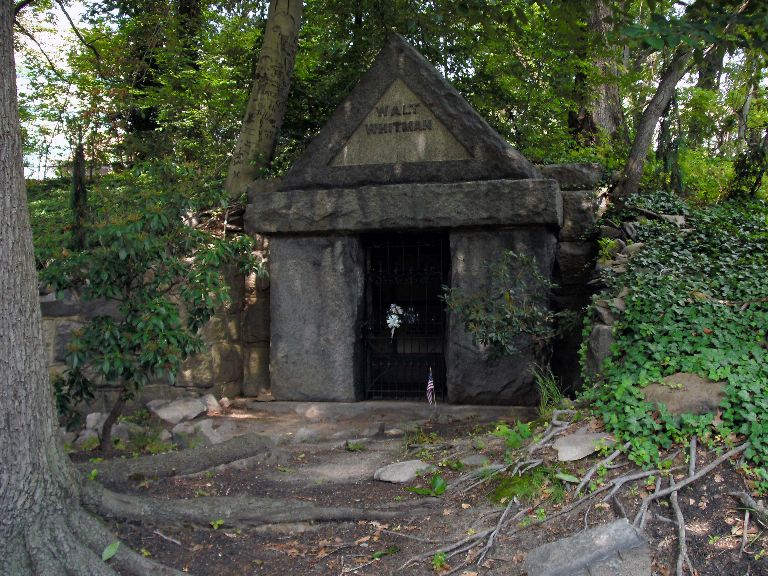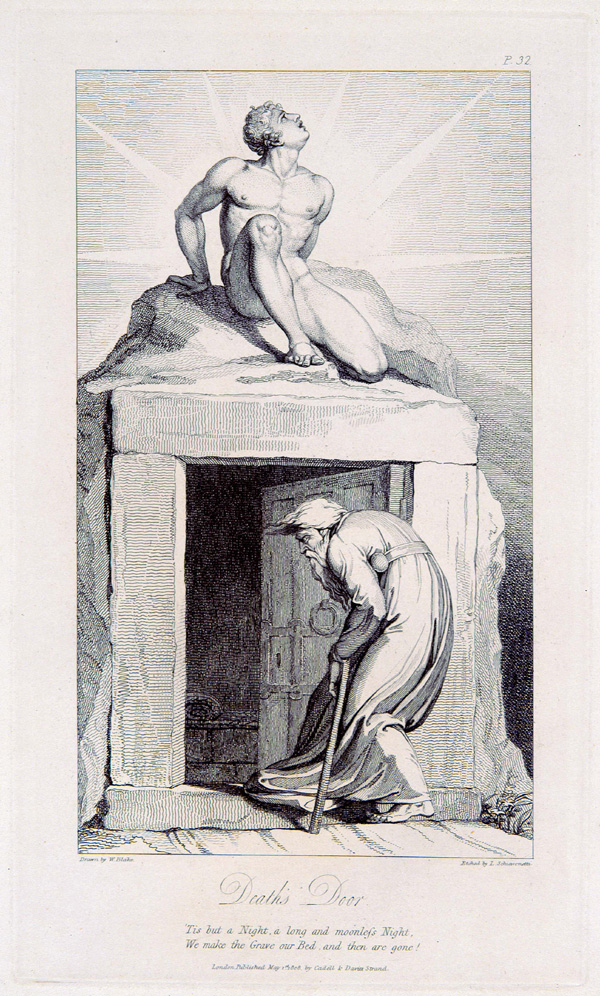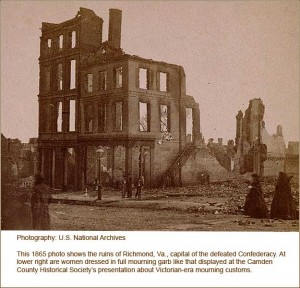October 20th, 2009 § § permalink
The Tomb of Walt Whitman

Walt Whitman’s final resting place is located in Harleigh Cemetery in Camden, New Jersey. The cemetery opened in 1885, only seven years before Whitman’s death, making it one of the oldest cemeteries in New Jersey. The cemetery covers over 130 acres of land, full of trees, sloping hills and gardens (Wikipedia).
In 1890, Whitman began making preparations for the spot of his burial, signing a contract for $4000 for the construction of a “burial house” in the cemetery, sturdy and geometric, carved roughly of granite with his name emblazoned on the front stone face. But what moved Whitman, usually the model of frugality, to decide on such an expensive burial structure?
Although Whitman grew up in poverty, by the last fifteen years of his life in Camden his salary averaged $1200 a year, a third more than the standard salary of an American worker (Reynolds, p. 32). By that standard, the cost of the tomb was over three times his annual salary. But Whitman cleverly relied on his good connections to pull him through the transaction–after paying the first $1500, he refused to pay for the last installment, relying on a rich friend to pick up the rest of the tab. Yet Whitman was quite liberal with the rest of his estate and possessions, giving liberally to his family members, five of which occupy the tomb along with him.
Young Harleigh Cemetery
One question that arises regards Whitman’s choice of such a young graveyard in which to build his tomb. Practical concerns such as space for the large stone structure were certainly concerns, and Whitman undeniably had the choicest pickings of the site for his location. But there seems to be evidence that Whitman may have been given a good deal by Harleigh Cemetery. According to one source, the cemetery convinced Whitman to pick a plot in order to increase business. By burying Whitman, a famous poet as well as a Camden local, Harleigh Cemetery rose in value and in business dramatically (Tomb of Walt Whitman Camden NJ).

Blake’s “Death’s Door”
The model for Whitman’s tomb is based on William Blake’s engraving, “Death’s Door” which Whitman discovered in 1881 (Ferguson-Wagstaffe). Whitman submitted a sketch to his literary executor, with the comment, “Walt Whitman’s Burial Vault–on a sloping wooded hill–grey granite–unornamental–surrounding trees, turf, sky, a hill everything crude and natural.” Whitman’s concept of a tomb was one carved out of nature, part of the earth yet separate from it. It is clear that Whitman intended to make a statement, but he disliked the grand, European style of mausoleums. The result is of Whitman’s desires was a tomb built to be earthen and sturdy, rather than polished and refined.
Burial Rituals
 Rituals regarding burial began to change in the nineteenth century, leading to new practices and a new design of graveyard. The Civil War was one of the catalysts, quickly robbing many households of fathers and sons–totaling up to approximately 600,000 casualties (Historic Camden County). Isolated burial grounds soon gave way to cemeteries that took the form of pubic parks. Victorian garden landscapes became the standard, where relatives would come to pray for, and picnic with, the deceased. Harleigh Cemetery represents one of these, founded after the civil war. Whitman’s request for a tomb was not unusual during this period of public graveyard revival.
Rituals regarding burial began to change in the nineteenth century, leading to new practices and a new design of graveyard. The Civil War was one of the catalysts, quickly robbing many households of fathers and sons–totaling up to approximately 600,000 casualties (Historic Camden County). Isolated burial grounds soon gave way to cemeteries that took the form of pubic parks. Victorian garden landscapes became the standard, where relatives would come to pray for, and picnic with, the deceased. Harleigh Cemetery represents one of these, founded after the civil war. Whitman’s request for a tomb was not unusual during this period of public graveyard revival.
Today Whitman’s tomb remains a site for the public, both of his literary fans and of roaming tourists. The tomb remains unchanged on a grassy hillside in Harleigh cemetery, open to visitors.
In Autumn Rivulets, Whitman’s Outlines for a Tomb ends with a passage of the narrator transcending the borders of America and beyond.
O thou within this tomb,
From thee such scenes, thou stintless, lavish giver,
Tallying the gifts of earth, large as the earth,
Thy name an earth, with mountains, fields and tides.
Nor by your streams alone, you rivers,
By you, your banks Connecticut,
By you and all your teeming life, old Thames,
By you Potomac laving the ground Washington trod, by you Patapsco,
You Hudson, you endless Mississippi–nor you alone,
But to the high seas launch, my thought, his memory.”
Instead of being weighed down by death, the narrator transcends borders with his thoughts. In this way, Whitman transcends his own death, not only through the erection of his tomb, but through the survival of his poetry and prose and those who study and learn by his works.
Works Cited
Fergusun-Wagstaffe, Sarah. “‘Points of Contact’: Blake and Whitman–Sullen Fires Across the Atlantic: Essays in Transatlantic Romanticism.” Harvard University. Romantic Circles. University of Maryland.
“Harleigh Cemetery, Camden.” <http://en.wikipedia.org/wiki/Harleigh_Cemetery,_Camden> Wikipedia.
Levins, Hoag. “Civil War-Era Death and Mourning Customs and Rituals” HistoricCamdenCounty.com. October 28th, 2002. <http://historiccamdencounty.com/ccnews43.shtml>
Reynolds, David S. Walt Whitman: Benjamin Franklin’s Representative Man. Modern Language Studies, Vol. 28, No. 2 (Spring, 1998), p. 29-39.
“Tomb of Walt Whitman, Camden NJ, American Guide Series on Waymarking.com” Waymarking.com. <http://www.waymarking.com/waymarks/WM70J8_Tomb_of_Walt_Whitman_Camden_NJ>
October 20th, 2009 § § permalink
All of us are familiar with Whitman’s fascination with physiognomy, the assessment of a person’s character by their outward appearance. From what I’ve heard, he had his own head read on several occasions.
It makes sense, then, that Whitman donated his own brain to science upon his death. His brain was kept preserved at the Wistar Institute at the University of Pennsylvania, as part of a collection of other brains from intelligent and renowned figures.
Unfortunately, at some point in time Whitman’s brain was dropped by a lab assistant–and therefore ruined and discarded.
Poor Whit–he must have turned over in his grave.
For the curious, here is the article where I found this.
October 20th, 2009 § § permalink
“For want of anything better, let me lightly twine a spring of the sweet ground-ivy trailing so plentifully through the dead leaves at my feet…and lay it as my contribution on the dead bard’s grave” (941).

 Although they were contemporaries, the writing of Henry Wadsworth Longfellow and Walt Whitman could not be more different. Longfellow was by far the era’s most popular poet, a “fireside poet” whose poems for adults and children were popular with the masses. Whitman, the rabble rouser, wrote poetry for the masses, but was not quite as popular as Longfellow with the common man. Perhaps Longfellow’s charming rhymes, gentle cadence and mild, uncontroversial subject matter was better suited as recreation for the layman’s lifestyle. Whitman was beloved by his fans, attracting notice by British readers for his revolutionary work.
Although they were contemporaries, the writing of Henry Wadsworth Longfellow and Walt Whitman could not be more different. Longfellow was by far the era’s most popular poet, a “fireside poet” whose poems for adults and children were popular with the masses. Whitman, the rabble rouser, wrote poetry for the masses, but was not quite as popular as Longfellow with the common man. Perhaps Longfellow’s charming rhymes, gentle cadence and mild, uncontroversial subject matter was better suited as recreation for the layman’s lifestyle. Whitman was beloved by his fans, attracting notice by British readers for his revolutionary work.
In Specimen Days on April 3rd, 1882, Whitman learns about the death of Longfellow through the newspaper and reminisces on the accomplishments of the fellow poet. His comments seem to weigh disapproval with plentiful praise, beginning with, “Longfellow in his voluminous works seems to me not only to be eminent in the style and forms of poetical expression that mark the present age, (an idiosyncrasy, almost a sickness, of verbal melody,) but to bring what is always dearest as poetry to the general human heart and taste” (941.) Whitman is not a fan of Longfellow’s insistent use of rhyme, the usage of which is not mere style, but a sickness, a dependance on formal verse. Poetry that reads like a song is suited to the common man’s taste, but this appears to be a degradation rather than an enhancement of the form. Longfellow adapts poetry to be readable by a large audience, simplifying it and its art for the general populace.
Yet Whitman goes on to claim that Longfellow represents “the sort of bard and counteractant most needed for our materialistic, self-assertive, money-worshipping Ango-Saxon races, and especially for the present age in America–an age tyrannically regulated with reference to the manufacturer, the merchant, the financier, the politician and the day workman–for whom and among whom he comes as the poet of melody, courtesy, deference” (942). Longfellow is the one poet to take the gift of poetry beyond the literary minded and share its music and its power with the everyday workman. In this way, Longfellow democracizes poetry, making it accessible to all those who are able to read. Poetry now has its place beside storytelling and biblical texts as one of America’s most popular literary pastimes.
Longfellow is the “universal poet of women and young people”–a poet of sentimentality (942). Whitman defends Longfellow from his critics who claim that the poet’s lack of originality. Originality is dependent on the exploration and study of the literary figures and works of the past. Before America, the New World, “can be worthily original, and announce herself and her own heroes, she must be well saturated with the originality of others, and respectfully consider the heroes that lived before Agamemnon” (943).
October 13th, 2009 § § permalink
Everyone has heard of the Tomb of the Unknown Soldier in the Arlington National Cemetery in Virginia. Just as the monument honors the nameless and unrecovered soldiers of our country’s wars, Whitman also sets his pen to do justice to the unburied and forgotten brave heroes of the civil war:
No formal general’s report, nor book in the library, nor column in the paper, embalms the bravest, north or south, east or west. Unnamed, unknown, remain, and still remain, the bravest soldiers. (Whitman, p. 748.)

Unnamed Remains the Bravest Soldier is one passage of many that celebrate the strength of America’s fighting youth, both on the field and in the hospitals. Whitman gives name to these men, abbreviating some to protect their privacy, but details their bravery in the face of pain and death, their strong silence and humbleness and their struggle and will to survive. Each case or “specimen” in Whitman’s work gives a unique and individual clause to the greater work, bringing the account of the war down to a personal, humanitarian level.
Whitman spoke in the preface to Leaves of Grass that America was itself one great poem, and that a poet of the people must write from the level of the common man. Therefore, Whitman does not wax patriotic with stories of the heroism of the generals of the war, but details the ins and outs of the cavalry and infantry. Even his passages about Lincoln describe the president as humble, courteous and yet deep and distinguished in the sadness in his face. Lincoln and his wife go about attired in black in a simple carriage, and while the president is alone he goes with a small ensemble of cavalry at the insistence of this men.
The hot-blooded patriotism of Whitman’s early poems is absent here, replaced with gruesome scenes of the hospital and the field. Whitman describes a battlefield in a fiery wood in A Night Battle, Over a Week Since. Both the wounded and the dead are consumed in the fire, flames that echo the burns that soldiers sustain if they survive the enemy cannon fire. Other scenes describing amputation, gangrene and violent hemorrhages range from stirring to deeply disturbing. Most of the soldiers are young, often between ages sixteen and twenty-one, and often described as farm boys–those who have little stake in the struggle between plantation owners and northern factory workers.
In Europe’s many military conflicts it came as no surprise that wars were waged by the rich with the ranks of the poor. America may claim to be different, but the reality of the Civil War proves that even democracy does not prevent this bitter, cruel reality from occurring.
October 6th, 2009 § § permalink
Each time I read Whitman’s verse on Lincoln it never fails to inspire me.

Lincoln's funeral train
Lincoln was the first president whose funeral was taken to the public on a grand scale–his coffin was set on a thirteen day journey by train. The train and its attendees traveled from Washington to Springfield, Illinois, through seven states and several major cities. Hundreds of thousands of people attended the viewing of the president in Philadelphia alone.
According to accounts “Long lines of the general public began forming by 5:00 A.M. At its greatest, the double line was three miles long and wound from the Delaware to the Schuylkill. Philadelphia officials estimated 300,000 people passed by Mr. Lincoln’s open coffin. The wait was up to five hours. So many people wanted to view Mr. Lincoln’s body that police had difficulty maintaining order in the lines; some people had their clothing ripped, others fainted, one broke her arm.”
Lincoln’s death was universally mourned, and Whitman’s elegy for the president is emotionally stirring, evoking both the poet as a lone mourner as well as the throngs that flocked to behold the president in death. Whitman describes the journey of the coffin through the rural landscapes of America as it travels from east to west. But the poem does not linger on the journey itself, but also grasps a greater effect by detailing Lincoln’s “burial house”–the symbols that represent the great man:
Pictures of growing spring and farms and homes,
With the Fourth-month eve at sundown, and the gray smoke lucid and bright,
With floods of the yellow gold and gorgeous, indolent, sinking sun, burning, expanding the air,
With the fresh sweet herbage under foot, and the pale green leaves of the trees prolific…
And the city at hand with dwellings so dense, ands tacks of chimneys,
And all the scenes of life and the workshops, and the workmen homeward returning (462.)
Whitman immortalizes Lincoln as the morning star, the star that sets in the west with his death. The narrator is then held between the thrush’s poetic exuberance on death and the mournful pull of memory of Lincoln in life. Death is celebrated as a companion, a universal force worthy of praise, an escape from the suffering of living. Yet the narrator moves between these two forces throughout the entire poem, only to escape the cycle and move beyond the lilac and the star at its very conclusion. The poem ends with praise for “the sweetest, wisest soul of all my days and lands” and the release of Lincoln into the embrace of death and his immortalization through the ode.
 Rituals regarding burial began to change in the nineteenth century, leading to new practices and a new design of graveyard. The Civil War was one of the catalysts, quickly robbing many households of fathers and sons–totaling up to approximately 600,000 casualties (Historic Camden County). Isolated burial grounds soon gave way to cemeteries that took the form of pubic parks. Victorian garden landscapes became the standard, where relatives would come to pray for, and picnic with, the deceased. Harleigh Cemetery represents one of these, founded after the civil war. Whitman’s request for a tomb was not unusual during this period of public graveyard revival.
Rituals regarding burial began to change in the nineteenth century, leading to new practices and a new design of graveyard. The Civil War was one of the catalysts, quickly robbing many households of fathers and sons–totaling up to approximately 600,000 casualties (Historic Camden County). Isolated burial grounds soon gave way to cemeteries that took the form of pubic parks. Victorian garden landscapes became the standard, where relatives would come to pray for, and picnic with, the deceased. Harleigh Cemetery represents one of these, founded after the civil war. Whitman’s request for a tomb was not unusual during this period of public graveyard revival.


 Although they were contemporaries, the writing of Henry Wadsworth Longfellow and Walt Whitman could not be more different. Longfellow was by far the era’s most popular poet, a “fireside poet” whose poems for adults and children were popular with the masses. Whitman, the rabble rouser, wrote poetry for the masses, but was not quite as popular as Longfellow with the common man. Perhaps Longfellow’s charming rhymes, gentle cadence and mild, uncontroversial subject matter was better suited as recreation for the layman’s lifestyle. Whitman was beloved by his fans, attracting notice by British readers for his revolutionary work.
Although they were contemporaries, the writing of Henry Wadsworth Longfellow and Walt Whitman could not be more different. Longfellow was by far the era’s most popular poet, a “fireside poet” whose poems for adults and children were popular with the masses. Whitman, the rabble rouser, wrote poetry for the masses, but was not quite as popular as Longfellow with the common man. Perhaps Longfellow’s charming rhymes, gentle cadence and mild, uncontroversial subject matter was better suited as recreation for the layman’s lifestyle. Whitman was beloved by his fans, attracting notice by British readers for his revolutionary work.
